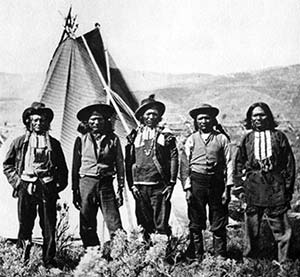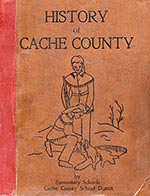Pocatello's Revenge ~ Index

Chief Pocatello who led a small band of Indians, a part of the Shoshone tribe ruled over by the Great Chief and white man's friend, Washakie, placed a spy among the villagers at Mendon for the purpose of keeping him informed as to every movement of the whites, their food supplies and measures for protection. The word Pocatello means One who will not keep the middle of the road
and this chief lived up to his name. He was hated as well as feared by the whites all through Cache Valley, the hunting ground of this outlaw chief.
There at Mendon his spy was as hateful as the chief and became a public nuisance, always listening, peeking, meddling. If two or three folks stopped to talk at a corner, there this Old Buck would be leaning idly against a post, listening. While the folk were gathered at church, the old fellow could be seen moving about peeking into everything, then off he would go each morning to report to his chief.
At a meeting of several of the leading men of the town it was decided to drive this old Indian from its boarders and forbid him to enter again. Three men were delegated to carry out this decision. The three men moved in on the old fellow just as it was getting dark and drawing their knives ordered the spy to leave. Whether he misunderstood this as an attack, we do not know, but he drew his own knife and rushed at one of the men who plunged his knife into the Indian's heart. As he fell dead at his feet he remarked rather sourly, Well, that's one more good Indian gone.
The rest of the men did not take it so calmly and wrapped the body of the Indian in a buffalo robe and carried it to the outskirts of the town, near by a pond and buried him in the field, carefully collecting all the dirt from the bottom of the grave in a blanket to insure that no trace would be left. After the dirt was placed back in the grave the field was plowed that same night with ox teams and hand plows.
The next morning as if by magic Chief Pocatello and twenty of his braves appeared on the streets of the town and without a word began to search for the Old Spy. All day they looked everywhere and in and under everything that might hide a body; they even walked over the very field that held the secret grave.
As the long shadows heralded the coming of night the Chief and his braves came again to the center of town and Pocatello, standing like a bronze statue shook his fist at the silent closed doors and shouted so all could hear, I'll make you pay for this.
The Indians left and a sigh of relief could be heard from every house. Then life went on again as usual.
The threat was almost forgotten in the rush of spring work but on April 7th, 1868, thirty days later, the whole Valley was aroused by the news that George W. Thurston's baby girl, two and one-half year old, had been stolen from her home by Indians.
George Thurston and Kelsey Bird had built a flour mill on Garners Creek, in the summer of 1864 and Thurston, with his family lived at the mill, which was about two miles south of Mendon and managed its operations. This afternoon of April 7th, while the old water wheel turned the squeaking machinery of the old mill, an April shower came up. Mr. Thurston called the children in but Rosie did not come in with the rest of the children. Every foot of ground carefully searched for tracks. At last in some tall grass was found a spot where two Indians had hidden; the baby girl's footprints ended here. Pocatello had struck. Little Rosie was never recovered but in later years an old Indian (Sagwitch to Peter Maughan) told how the little girl had died only a few years after she was stolen, of pneumonia.1
Some Thoughts

The above was written by the children of the Mendon Elementary school in 1938 and then gone over again in 1946. The Cache County School District did a History of Cache County, written by the various school children around the valley. Most likely in preparation for the upcoming 1947 Pioneer Centennial celebration. Although it would seem to be embellished a great deal, the event did happen here in Mendon. This death of one of Pocatello's band, may well be the root cause for the stealing away of Little Rosie Thurston. I think we will find the bones of this Indian in one of the fields south-east of town, as development swallows up this part of the valley. I understand he was killed with a knife and buried as described, in such a way as to hide the evidence from the tribe. Plowing at night, to hide the location of the hastily prepared grave. Pocatello could never prove his missing brave was killed. But the stark facts of him disappearing would lend a powerful hand in his determination of the event.
Then Indians were fond of stealing white children when ever they could. Several attempts were made in Cache Valley and one child, Reuben Van Ornum, was taken from a wagon train headed for Oregon and was later recovered at Providence, Utah. Little Rosa Thurston however is one of the most tragic events of the local Mendon area. Several endings to the story have been offered… no one is sure what happened to her once the Indians took her from her home on Gardner's Creek.
I have always viewed Pocatello as a Bad Indian.
Having been told this story and hearing the settlers point of view towards him as a child. But, one man's Freedom Fighter is another's Terrorist, and the world we still seem to live in. I suppose to his people he was thought quite well of. I can understand that. What is right and what is wrong depends a great deal on whom one asks. I am good to just let it all go. Nothing can be done at present, no charges against anyone can nor will ever be filled. It is just a very interesting footnote in our local history, and has become local folklore in many ways.
Mendon was so small at this time, that I figure that most of the men and many of the women knew of the plan to ask this Indian to leave. The only person whom would not be implicated, would be the bishop or presiding elder at the time, Ralph Forster. As he was in a direct line with the church authorities, so he needed and had to be keep out of the loop. Thus he could answer with a clear conscience that he knew not of the deed nor plot. Men were chosen who could Do the Job, and it was done. That the Indian was killed, was certainly not the plan, but one of many outcomes that such a risky situation presented. No one was happy with the results, but it ended badly for the brave and caused a great fear in the town. Reprisals and retribution would be, or could be severe. Not a good place for the small town of Mendon to be in.
I know that the news of this death, in violation of the rule of the time, that it was better to feed the Indians than fight them, made Brigham Young pound his fist in anger on the pulpit in the Spanish Fork area as he spoke of it. He was not pleased, to say the least and said the same. He said that the hand of the man that killed the Indian would wither away, and it would seem that this happened. But no one would ever turn over the man whom killed the Indian. I suppose this as much as anything infuriated the Prophet. But it was thought wisdom at that time in Mendon's history to have the Old Spy removed from town. This was a bit much for the towns folks to take, knowing the Indians meant them no good. In a clash of cultures, there are often victims. We have two of them here.
Notes…
- History of Cache County, Cache County School District Children and Teachers, et al., 1938 & 1946, page 108–109.